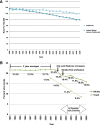Reducing tobacco-related cancer incidence and mortality: summary of an institute of medicine workshop
- PMID: 24304712
- PMCID: PMC3903060
- DOI: 10.1634/theoncologist.2013-0230
Reducing tobacco-related cancer incidence and mortality: summary of an institute of medicine workshop
Abstract
Tobacco use remains a serious and persistent national problem. Recognizing that progress in combating cancer will never be fully achieved without addressing the tobacco problem, the National Cancer Policy Forum of the Institute of Medicine convened a public workshop exploring current issues in tobacco control, tobacco cessation, and implications for cancer patients. Workshop participants discussed potential policy, outreach, and treatment strategies to reduce tobacco-related cancer incidence and mortality, and highlighted a number of potential high-value action items to improve tobacco control policy, research, and advocacy.
摘要
在美国长期以来烟草使用一直为全国性的重要问题。现已认识到,如果不解决烟草问题,抗击癌症则永远不能得到充分进展。美国医学研究所的癌症政策论坛召开了公共研讨会,旨在探索烟草控制、戒烟及其对癌症患者的意义等当前议题。研讨会参与者讨论了可能的政策、扩发服务以及治疗策略来降低吸烟相关的癌症发生率与死亡率,着重指出了一系列潜在价值很高的行动措施,以期改善烟草控制的政策、研究及其倡导主张。The Oncologist 2014;19:1-10
Keywords: Cancer; Tobacco cessation; Tobacco prevention and control; Tobacco use.
Figures


References
-
- Centers for Disease Control and Prevention (CDC) Smoking-attributable mortality, years of potential life lost, and productivity losses—United States, 2000-2004. MMWR Morb Mortal Wkly Rep. 2008;57:1226–1228. - PubMed
-
- American Cancer Society. Cancer Facts & Figures 2012. Available at http://www.cancer.org/acs/groups/content/@epidemiologysurveilance/docume.... Accessed November 26, 2013.
-
- Institute of Medicine . Reducing Tobacco-Related Cancer Incidence and Mortality: Workshop Summary. Washington, D.C.: The National Academies Press; 2012. - PubMed
-
- Centers for Disease Control and Prevention (CDC). Figure 8.1. Prevalence of Current Smoking Among Adults Aged 18 and Over: United States, 1997–2011. Available at http://www.cdc.gov/nchs/data/nhis/earlyrelease/earlyrelease201206_08.pdf. Accessed November 26, 2013.
-
- Centers for Disease Control and Prevention (CDC) Tobacco use—United States, 1900-1999. MMWR Morb Mortal Wkly Rep. 1999;48:986–993. - PubMed
Publication types
MeSH terms
LinkOut - more resources
Full Text Sources
Other Literature Sources
Medical

